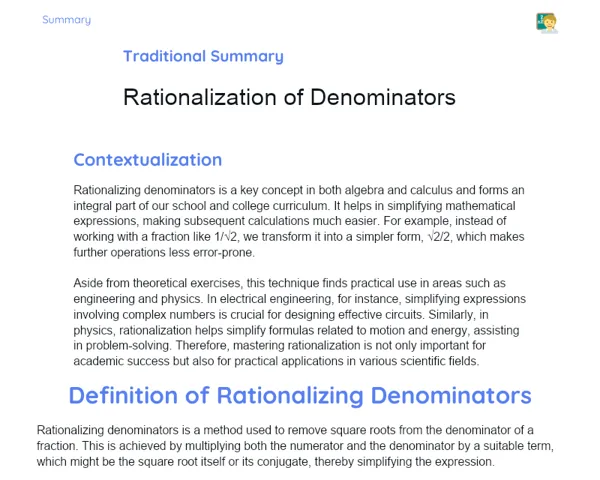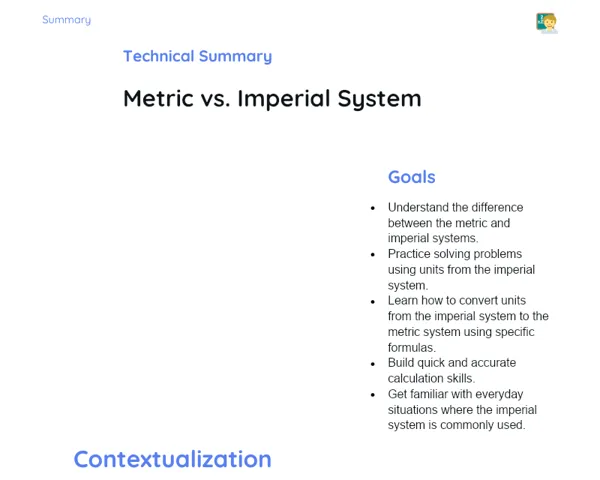Goals
1. Understand the formula for calculating the volume of a pyramid: base area times height divided by three.
2. Apply this formula in both practical and theoretical scenarios.
3. Appreciate the significance of calculating the volume of pyramids in real-world scenarios, including fields like engineering and architecture.
Contextualization
Imagine you are a civil engineer tasked with constructing a landmark similar to the iconic Great Pyramid of Giza. To ensure your project is a success, mastering the calculation of the pyramid's volume is crucial. This figure is fundamental in determining the amount of materials required, estimating costs, and ensuring structural integrity. Thus, grasping the volume of a pyramid goes beyond a mere academic exercise; it is an essential practical skill applicable to several professions.
Subject Relevance
To Remember!
Concept of Pyramid and Its Characteristics
A pyramid is a geometric shape with a polygonal base and triangular faces that converge at a singular point known as the vertex. Pyramids can have bases of various shapes, including squares, triangles, or rectangles, yet maintain the defining trait of triangular lateral faces.
-
Polygonal Base: The base can be any polygon, such as a square, triangle, or rectangle.
-
Lateral Faces: All lateral faces are triangular in shape.
-
Vertex: The common point where all the lateral faces join.
Formula for Calculating the Volume of a Pyramid
The volume of a pyramid can be calculated using the formula: Volume = (Base Area × Height) / 3. Here, the base area varies based on the shape of the polygon constituting the pyramid’s base, and the height is the perpendicular distance from the vertex to the base.
-
Base Area: Determined by the shape of the pyramid's base.
-
Height: The perpendicular distance from the vertex to the base of the pyramid.
-
Division by Three: The volume is one-third of the product of the base area and height.
Practical Applications of Calculating Pyramid Volumes
Calculating pyramid volumes plays a critical role in practical domains such as civil engineering, architecture, and mining. These calculations are necessary for assessing the quantity of materials required, estimating costs, and ensuring the stability and safety of structures.
-
Civil Engineering: Calculation of required materials and associated costs in construction projects.
-
Architecture: Designing efficient and visually appealing spaces.
-
Mining: Estimating materials extracted from pyramidal configurations.
Practical Applications
-
Civil Engineering: Calculate the volume of concrete needed for constructing a glass pyramid in a contemporary building.
-
Architecture: Design a monument or structure shaped like a pyramid, ensuring efficient use of space.
-
Mining: Determine the volume of material extracted from a pyramid-shaped excavation.
Key Terms
-
Pyramid: A geometric solid characterized by a polygonal base and triangular lateral faces.
-
Vertex: The point where all the triangular faces of a pyramid converge.
-
Base Area: The area of the polygonal base of the pyramid.
-
Height: The perpendicular distance from the vertex to the base of the pyramid.
-
Volume: A measure of the space occupied by the pyramid, calculated as (Base Area × Height) / 3.
Questions for Reflections
-
How does precision in volume calculations influence the safety and efficacy of a construction project?
-
What distinguishes the volume calculation of a pyramid from that of other geometric figures?
-
How can the ability to calculate the volume of pyramids be utilized in other fields beyond engineering and architecture?
Cardboard Pyramid Challenge
Create a scaled version of a pyramid using cardboard and compute its volume.
Instructions
-
Form groups of 4 to 5 students.
-
Utilize cardboard, a ruler, scissors, and glue to build a pyramid with a square base measuring 10 cm on each side and a height of 15 cm.
-
Cut out the faces of the pyramid based on the dimensions provided and assemble the structure.
-
Use the formula: (Base Area × Height) / 3 to calculate the volume of the pyramid.
-
Compare the calculated volumes across groups and discuss any differences noted.
-
Present your constructed pyramid while explaining the calculation procedure and any challenges encountered.



